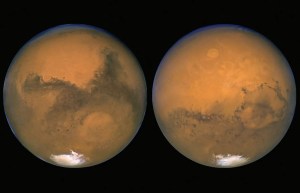
Hubble Mars Close Approach 2003
These two images, taken 11 hours apart with NASA’s Hubble Space Telescope, reveal two nearly opposite sides of Mars. Hubble snapped these photos as the red planet was making its closest approach to Earth in nearly 60,000 years. The image at left (A) was taken August 26, 2003, several hours before Mars had its closest encounter with Earth. The prominent Martian features in this photo are Syrtis Major, the “shark-fin” shape on the right, and the Hellas impact basin, the circular feature near the center of the image. The image at right (B) was snapped within minutes of the red planet’s close rendezvous with Earth on August 27, 2003. When this photo was taken, the two planets were 34,647,420 miles (55,757,930 kilometers) apart. Mars is a mere 1,400 miles closer to Earth in this picture than in the one taken 11 hours earlier. The striking features in this image are Olympus Mons [oval-shaped object just above center], the largest volcano in the solar system, and Solis Lacus, an immense dark marking also known as the “Eye of Mars” [below, right]. Mars’s surface area roughly equals the combined area of Earth’s seven continents. The smallest features in these images measure 17 miles across. Both images show most of the southern polar ice cap. The pictures were taken during the middle of summer in the Southern Hemisphere. During this season the Sun shines continuously on the southern polar ice cap, causing the cap to shrink in size (bottom of both images). The orange streaks are indications of dust activity over the polar cap.
- X




























